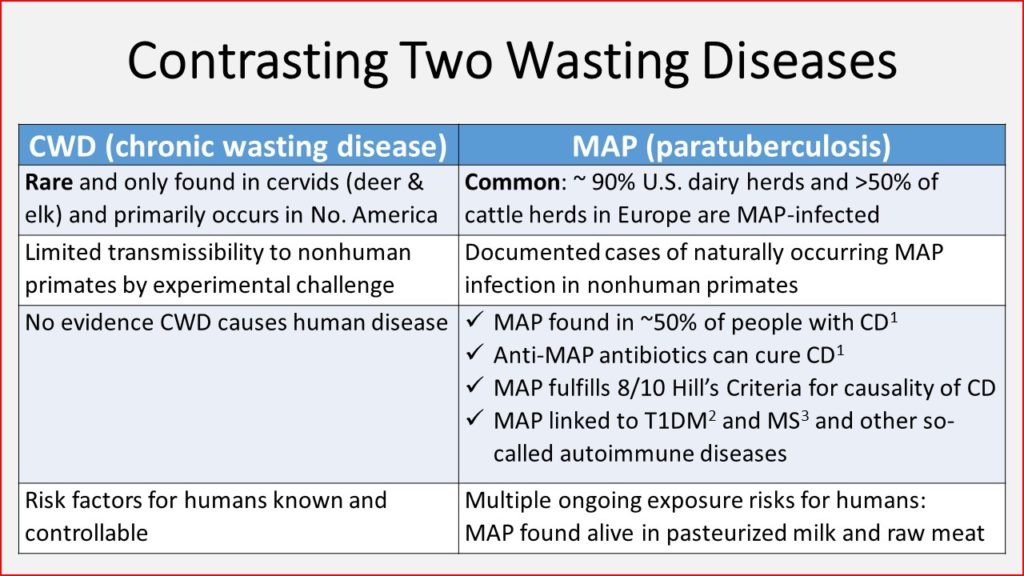![]()
Chronic Wasting Disease (CWD) is in the news as experts raise concerns about its unchecked spread. Read here the Opinion/Hypothesis article in the July/August issue of mBio titled: Chronic Wasting Disease in Cervids: Implications for Prion Transmission to Humans and Other Animal Species. The authors of the article conclude: Available data indicate that the incidence of CWD in cervids is increasing and that the potential exists for transmission to humans and subsequent human disease. Given the long incubation period of prion-associated conditions, improving public health measures now to prevent human exposure to CWD prions and to further understand the potential risk to humans may reduce the likelihood of a BSE-like event in the years to come.
Today’s Johnes.org news item contrasts CWD with a more common chronic wasting disease known as Johne’s disease (JD). I do this with the intention of questioning the relative importance of CWD and JD to society and urging science-based decisions on animal disease control investments. The evidence in the table below and the references that follow speak for themselves.

Footnotes:
- 1 Crohn’s disease affects more than 1 in 800 people in North America, and while the incidence has plateaued in more industrialized countries, since 1990 the incidence has been rising in newly industrialized countries in Africa, Asia, and South America, including Brazil.
- 2 Type 1 Diabetes Mellitus affects roughly 1 in 550 youth (<20 years old) in the U.S. and Canada, and the incidence is rising.
- 3 Multiple Sclerosis affects roughly 1 in 700 in the U.S., and the incidence is rising.
References and recommended reading:
- MAP as a zoonosis on this site: https://johnes.org/general-information/zoonotic-potential/
- Race, B. et al. 2014. Chronic wasting disease in nonhuman primates. Emerg Infect Dis 20(5): 833-837.
- Lombard, JE, et al. 2013. Herd-level prevalence of Mycobacterium avium subsp. paratuberculosis infection in United States dairy herds in 2007. Preventive Veterinary Medicine. 108:234-238.
- Nielsen, SS, and Toft, N. 2009. A review of prevalences of paratuberculosis in farmed animals in Europe. Prev Vet Med 88:1-14.
- Ellingson, JLE, et al. 2005. Detection of viable Mycobacterium avium subsp. paratuberculosis in retail pasteurized whole milk by two culture methods and PCR. J Food Protection 68(5):966-972.
- Chiodini, R. et al. 2012. Crohn’s disease and the mycobacterioses: A quarter century later. Causation or simple association? Critical Reviews in Microbiology 38(1):52-93.
- Ng, SC. 2017. Worldwide incidence and prevalence of inflammatory bowel disease in the 21st century: a systematic review of population-based studies. Lancet. 390:2769-2778.
- Waddell, LA, et al. 2015. Review Article: The zoonotic potential of Mycobacterium avium ssp. paratuberculosis: a systematic review and meta-analyses of the evidence. Epidemiol Infect 143:3135-3157.
- National Advisory Committee on Microbiological Criteria for Foods. 2010. Review: Assessment of Food as a Source of Exposure to Mycobacterium avium subspecies paratuberculosis (MAP). J Food Protect 73(7):1357-1397.
- Sechi, L. et al. 2008. Humoral immune responses of Type 1 Diabetes patients to Mycobacterium avium subsp. paratuberculosis lend support to the infectious trigger hypothesis. Clinical and Vaccine Immunology Feb:320-326.
- SEARCH for Diabetes in Youth. 2006. The Burden of Diabetes Mellitus among US youth: Prevalence estimates. Pediatrics 118(4).
- Dilokthornsakul, P. et al. 2016. Multiple sclerosis prevalence in the United States commercially insured population. Neurology 86(11).
- Cossu, D. et al. 2011. Association of Mycobacterium avium subsp. paratuberculosis with Multiple Sclerosis in Sardinian patients. PLoS One 6(4):e18482.